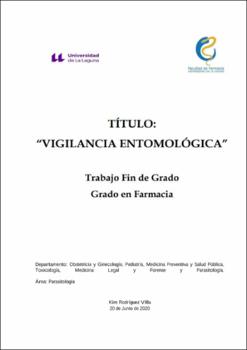Vigilancia entomológica
Autor
Rodríguez Villa, KimFecha
2020Resumen
Las enfermedades transmitidas por vectores, entre ellas las transmitidas por mosquitos
(Diptera: Culicidae), constituyen el grupo de alteraciones que se encuentran en auge
actualmente por la gran velocidad de extensión y alto porcentaje de afección. Esto implica
que los gobiernos incluyan en sus planes de actuación frente a estas enfermedades un sistema
de vigilancia entomológica para detectar y controlar a los mosquitos, y si es posible,
erradicarlo. Estos sistemas constan de una serie de actuaciones que deben estar preparadas
para poder alcanzar su objetivo. Considerando estos puntos se ha tratado de evaluar la
situación actual en España de los sistemas de vigilancia entomológica de mosquitos de interés
sanitario, y en concreto de los aedinos invasores por su importancia actual en Europa. La
información para ello se ha obtenido a partir de artículos científicos, tesis, documentos
técnicos, etc. Hoy en día, existen muchas comunidades autónomas que no poseen un sistema
de vigilancia entomológica como tal, aumentando el riesgo de sufrir enfermedades
transmitidas por mosquitos. Por lo tanto, es necesario que se establezcan sistemas y planes
estructurados que aporten una predisposición favorable frente el control, la detección y
erradicación del vector. Vector-borne diseases, including those transmitted by mosquitoes (Diptera:
Culicidae), constitute the group of disorders that are currently booming due to the high speed
of extension and high percentage of disease. This implies that governments include in their
action plans against these diseases an entomological surveillance system to detect and control
mosquitoes, and if possible, eradicate it. These systems consist of a series of actions that must
be prepared in order to achieve their objective. Considering these points, an attempt has been
made to evaluate the current situation in Spain of the entomological surveillance systems of
mosquitoes of sanitary interest, and specifically of invasive aedines due to their current
importance in Europe. The information for this has been obtained from scientific articles,
theses, technical documents, etc. Today, there are many autonomous communities that do not
have an entomological surveillance system as such, increasing the risk of mosquito-borne
diseases. Therefore, it is necessary to establish systems and structured plans that provide a
favorable predisposition against the control, detection and eradication of the vector.





